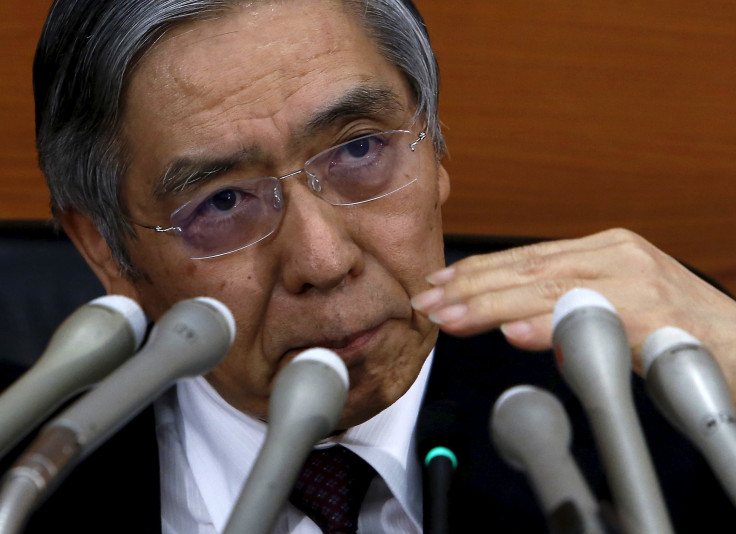Japan Negative Interest Rate: Abenomics Faces New Challenges As Bank Of Japan Stuns Global Markets

Japan’s signature plan for economic reform — known as “Abenomics” after the nation's prime minister, Shinzo Abe — is headed down an uncertain path. The Bank of Japan opted Friday to embrace negative interest rates at a time when Abe has lost a key economic adviser in his quest to end 20 years of tepid economic growth and repeated recessions.
The central bank’s governor, Haruhiko Kuroda, shocked financial markets with the announcement that it would impose a 0.1 percent fee — a negative interest rate — on deposits from commercial banks, essentially charging them for parking excess funds. Only weeks earlier, Kuroda had said the Bank of Japan was not seriously considering the step.
Negative interest rates, a policy now being pursued by the European Central Bank as well, attempt to stimulate economic growth by making it unprofitable for banks to hold too much cash. The hope is that the money then flows into higher-yielding investments that result in higher demand, greater spending and, eventually, higher inflation and a sustainable economic recovery.

Monetary policy is one of the “Three Arrows” of Abenomics. The other two are fiscal stimulus and structural reform of Japan’s regulation-ridden domestic economy, which is often protected from foreign competition.
Abe’s point man on structural reform was Akira Amari, the economy minister with a vast portfolio that includes negotiating a landmark free-trade agreement with the United States, the Trans-Pacific Partnership. But Amari fell this week to a scandal involving alleged cash payouts by a construction company, and his successor, Nobuteru Ishihara, doesn’t have the policy or political background that made Amari effective.
“While Ishihara is a heavyweight within [Abe’s party], it is unclear whether he will be able to match Amari's command of macroeconomic policy or whether he will be able to sell TPP effectively,” said Tobias Harris, a political risk analyst with Teneo, a consultancy. “Unlike Amari, he does not have a particularly close relationship with Abe.”
As Ishihara hustles to take the reins from Amari, Kuroda will be under pressure to show that negative interest rates give the central bank traction in its fight against deflation, something that’s not at all certain.
The chronically stagnant Japanese economy may not be able to be healed, even with extraordinary measures. The country’s population is graying rapidly, which means it can’t count on a larger labor force to raise economic output. “Monetary policy cannot defeat or reverse — or even affect — the negative effects of Japan’s depopulation,” Carl Weinberg, chief economist at High Frequency Economics, wrote in a research note.
Kuroda began his quest to fight off deflation in April 2013 with a strategy that had some pizazz: 2-2-2. That is, double the monetary base of yen in circulation within two years to reach 2 percent inflation.
Since then, the Bank of Japan has bought up financial assets worth trillions of yen, turning itself into the dominant player in Japan’s enormous bond market.
Sometimes unreliable gross domestic product numbers show Japan hit an annualized growth rate of 1 percent in December, but inflation is still stubbornly low. It was 0.8 percent per year, according to data for December, and appears to be decelerating.
The year started out badly, Kuroda admitted as he unveiled the bank’s negative-interest-rate policy, with Japanese firms spooked by turbulent markets and the uncertain outlook in China.
“Risks were growing that the slowdown in the Chinese, emerging and resource-producing countries, which has caused volatility and instability in financial markets since the beginning of the year, may hurt confidence among domestic companies,” Kuroda said as he unveiled the new policy.
The trick will be maintaining the positive effect of negative interest rates on the Japanese economy.
The yen tumbled immediately after the Bank of Japan’s announcement, and a sustained fall could boost Japanese exporters. But with the European Central Bank also pursuing heavy monetary stimulus — essentially printing euros — Kuroda can’t rely on the world to stand still as he conducts Japan’s experiment.
“It looks like there will be a competition on negative rates with central banks, including the ECB,” Mari Iwashita, chief market economist at SMBC Friend Securities Co. in Tokyo, told Bloomberg News. “The BOJ now has to defend its position in the race, which is likely to persist until uncertainties over emerging economies dissipate.”
It remains to be seen whether Japan’s foray into negative interest rates will dig the country deeper into a hole or be the spark for stronger economic growth.
© Copyright IBTimes 2025. All rights reserved.





















